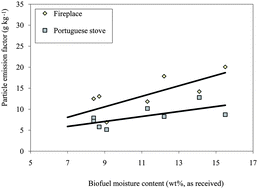Emission factors from residential combustion appliances burning Portuguese biomass fuels
Abstract
Smoke from residential wood

* Corresponding authors
a
Centre for Environmental and Marine Studies, Department of Environment, University of Aveiro, Aveiro, Portugal
E-mail:
apsfernandes@ua.pt
Fax: +351234370309
Tel: +351234370200
b Institute of Chemical Technologies and Analytics, Vienna University of Technology, Division of Environmental and Process Analytics, Getreidemark 9/164-UPA, Vienna, Austria
Smoke from residential wood

 Please wait while we load your content...
Something went wrong. Try again?
Please wait while we load your content...
Something went wrong. Try again?
A. P. Fernandes, C. A. Alves, C. Gonçalves, L. Tarelho, C. Pio, C. Schimdl and H. Bauer, J. Environ. Monit., 2011, 13, 3196 DOI: 10.1039/C1EM10500K
To request permission to reproduce material from this article, please go to the Copyright Clearance Center request page.
If you are an author contributing to an RSC publication, you do not need to request permission provided correct acknowledgement is given.
If you are the author of this article, you do not need to request permission to reproduce figures and diagrams provided correct acknowledgement is given. If you want to reproduce the whole article in a third-party publication (excluding your thesis/dissertation for which permission is not required) please go to the Copyright Clearance Center request page.
Read more about how to correctly acknowledge RSC content.
 Fetching data from CrossRef.
Fetching data from CrossRef.
This may take some time to load.
Loading related content
